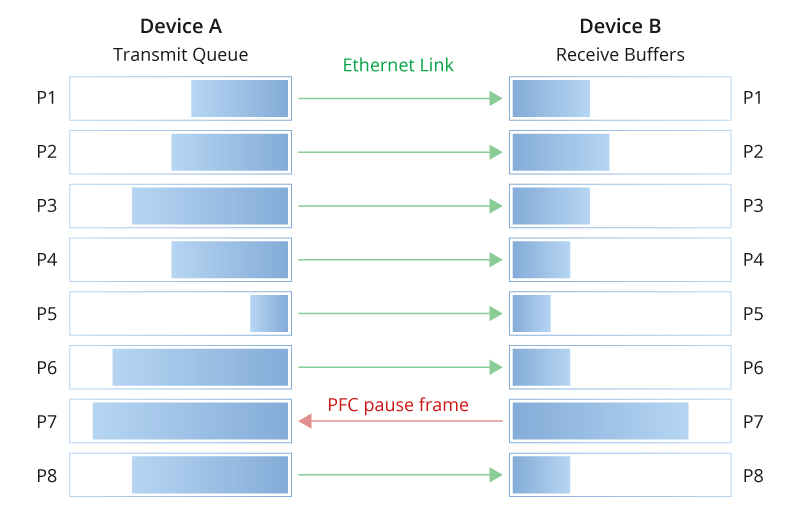Data center networks are continuously challenged to manage massive amounts of data and need to simultaneously handle different types of traffic, such as high-speed data transfers, real-time communication, and storage traffic, often on shared network infrastructure. That’s where Priority-based Flow Control (PFC) proves to be a game-changer.
What is Priority-Based Flow Control?
Priority-Based Flow Control (PFC) is a network protocol mechanism that’s part of the IEEE 802.1Qbb standard, designed to ensure a lossless Ethernet environment. It operates by managing the flow of data packets across a network based on the priority level assigned to different types of traffic. PFC is primarily used to provide Quality of Service (QoS) by preventing data packet loss in Ethernet networks, which becomes especially critical in environments where different applications and services have varying priorities and requirements.
How Does Priority-Based Flow Control Work?
To understand the workings of Priority-Based Flow Control, one needs to look at how data is transmitted over networks. Ethernet, the underlying technology in most data centers, is prone to congestion when multiple systems communicate over the same network pathway. When network devices become swamped with more traffic than they can handle, packet loss is typically the result. PFC addresses this problem by using a mechanism called “pause frames.”Pause frames are sent to a network device (like a switch or NIC) telling it to stop sending data for a specific priority level. Each type of traffic is assigned a different priority level and, correspondingly, a different virtual lane. When congestion occurs, the device with PFC capabilities issues a pause frame to the transmitting device to temporarily halt the transmission for that particular priority level, while allowing others to continue flowing. This helps prevent packet loss for high-priority traffic, such as storage or real-time communications, ensuring these services remain uninterrupted and reliable.

Why do We Need Priority-Based Flow Control?
Data centers serve as the backbone of enterprise IT services, and their performance directly impacts the success of business operations. Here’s why implementing PFC is vital:
- Maintains Quality of Service (QoS): In a diverse traffic environment, critical services must be guaranteed stable network performance. PFC preserves the QoS by giving precedence to essential traffic during congestion.
- Facilitates Converged Networking: The combination of storage, compute, and networking traffic over a single network infrastructure requires careful traffic management. PFC allows for this convergence by handling contention issues effectively.
- Supports Lossless Networking: Some applications, such as storage area networks (SANs), cannot tolerate packet drops. PFC makes it possible for Ethernet networks to support these applications by ensuring a lossless transport medium.
- Promotes Efficient Utilization: Properly managed flow control techniques like PFC mean that existing network infrastructure can handle higher workloads more efficiently, pushing off the need for expensive upgrades or overhauls.
Application of Priority-Based Flow Control in Data Centers
Here’s a closer look at how PFC is applied in data center operations to boost efficiency:
Managing Mixed Workload Traffic
Modern data centers have mixed workloads that perform various functions from handling database transactions to rendering real-time analytics. PFC enables the data center network to effectively manage these mixed workloads by ensuring that the right kind of traffic gets delivered on time, every time.
Maintaining Service Level Agreements (SLAs)
For service providers and large enterprises, meeting the expectations set in SLAs is critical. PFC plays a crucial role in upholding these SLAs. By prioritizing traffic according to policies, PFC ensures that the network adheres to the agreed-upon performance metrics.
Enhancing Converged Network Adapters (CNAs)
CNAs, which consolidate network and storage networking on a single adapter card, rely heavily on PFC to ensure data and storage traffic can flow without interfering with one another, thereby enhancing overall performance.
Integrating with Software-Defined Networking (SDN)
In the SDN paradigm, control over traffic flow is centralized. PFC can work in tandem with SDN policies to adjust priorities dynamically based on changing network conditions and application demands.
Enabling Scalability
As data centers grow and traffic volume increases, so does the complexity of traffic management. PFC provides a scalable way to maintain network performance without costly infrastructure changes.
Improving Energy Efficiency
By improving the overall efficiency of data transportation, PFC indirectly contributes to reduced energy consumption. More efficient data flow means network devices can operate optimally, preventing the need for additional cooling or power that might result from overworked equipment.
In conclusion, Priority-based Flow Control is a sophisticated tool that addresses the intrinsic complexities of modern data center networking. It prioritizes critical traffic, ensures adherence to quality standards, and permits the coexistence of diverse data types on a shared network. By integrating PFC into the data center network’s arsenal, businesses can not only maintain the expected service quality but also pave the way for advanced virtualization, cloud services, and future network innovations, driving efficiency to new heights.
